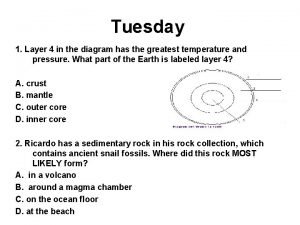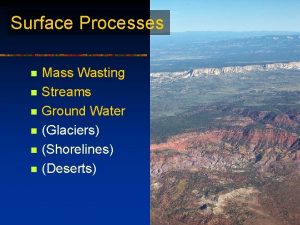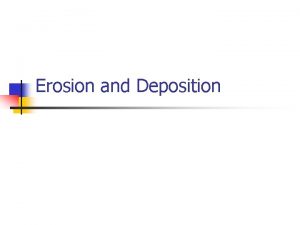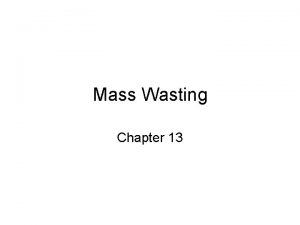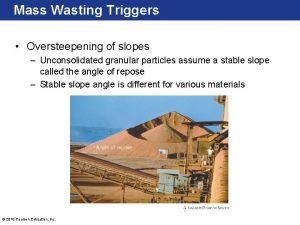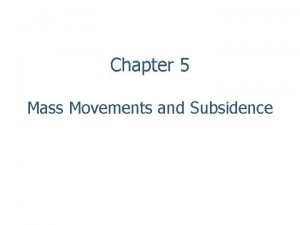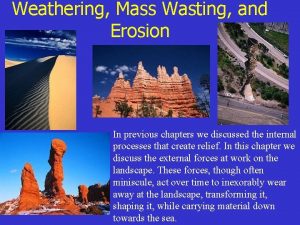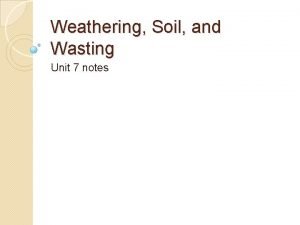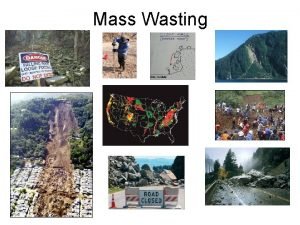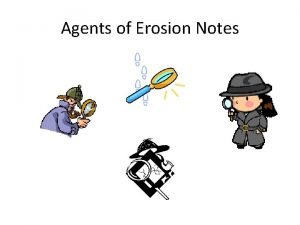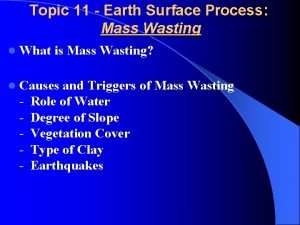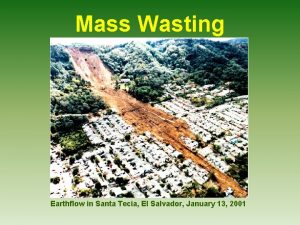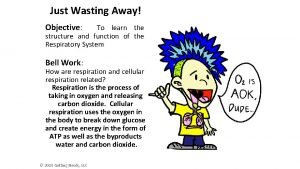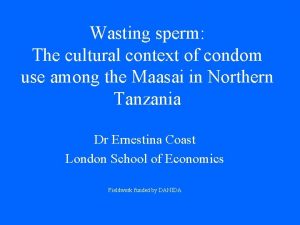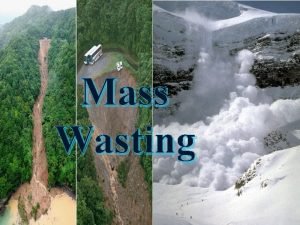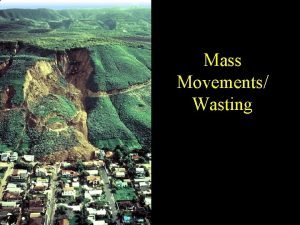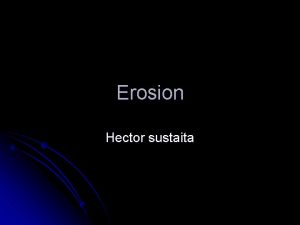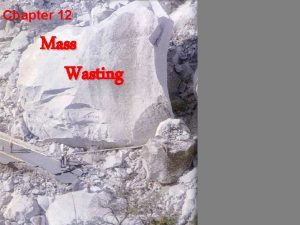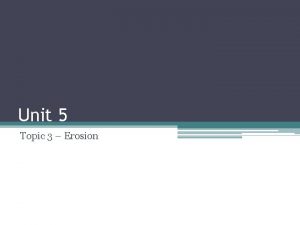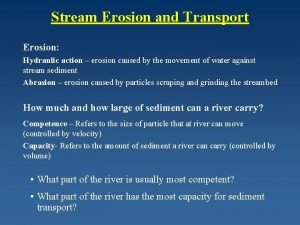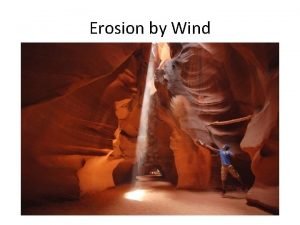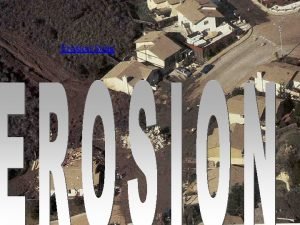Erosion Mass Wasting Mass Wasting Mass wasting is
















- Slides: 16

Erosion - Mass Wasting

Mass Wasting • Mass wasting is a type of erosion. Remember that erosion is the movement of sediment on Earth’s surface. • Mass wasting, also known as mass movement, is when gravity directly causes the movement of sediment. • The rock fall shown in Figure 1 is a simple example showing mass movement. Figure 1. The rock fall above occurred in 2009 at Yosemite National Park in California. It most likely was created as a result of frost wedging, however the actual process of it falling is considered mass wasting. This illustrates how the two processes are related.

Mass Wasting - Causes • An abundance of water is the primary cause of mass wasting events. Figure 2 illustrates the role water plays in these events. • If the ground contains a little water, because water is a polar molecule (it has a positive and negative end) it sticks to other water molecules making it cohesive. Think about if you have ever played in the sand. Dry sand is no good for making sand castles, however damp sand is great. • However, when the ground becomes saturated, the water now acts like a lubricant allowing the sediment to easily flow. A similar process happens when a road is wet and you are driving too fast. This is called hydroplaning. Figure 2. Diagram that shows the effect too much water can gave on mass wasting events.

Mass Wasting - Causes • The lack of vegetation is another major factor that can increase the probability of a mass wasting event. • There are two primary reasons for this. The roots from the trees will absorb a lot of water, making it harder for the ground to become saturated. The second reason is that the roots act like anchors and hold the soil in place.

The picture on the left is of the island Hispaniola, which is in the Caribbean Sea. The two countries that make up this island can be seen in the picture. Most of the forests have been destroyed in Haiti due to the deforestation. As a result, when it rains massive amounts of flooding and mass wasting occur which can be seen by looking at the picture on the right.

Trees are not the only type of vegetation that stabilize soil. The small grasses seen on this beach dune prevent the sand from blowing away. These dunes protect against storm surges that are associated with hurricanes. They also provide niches for biological activity. For example, sea tortoises will lay their eggs in the sand.

Types of Mas Wasting - Rock Falls • Not much needs to be said about rock falls. What is worth mentioning is that many rock falls are the result of other processes you have already learned about such as frost wedging and exfoliation.

Types of Mas Wasting - Slumps • When the ground becomes unstable, usually due to it becoming saturated, a sudden movement of the land can occur. • If the movement is smaller, these events are called slumps. If they are larger they are considered landslides.


A landslide that occurred in 2014 in Washington state.


Mudflows • The mudflow seen on the right is a special type of a mudflow called a lahar. These form as a result of volcanic eruptions. • The hot volcanic ash will mix with the melted snow on top of the volcanoes and create an incredible dangerous mudflow.

Creep The slowest type of mass wasting is called creep (Figure 3). Because this occurs very slowly, you can’t see the process occurring, however you can see the results of this and over the course of your lifetime it can have huge effects on the landscape. Figure 3. The bumps in this hill side is the result of soil creep. Due to seasonal freezing and thawing, soil slowly is able to flow downhill.

The curved trunk above and the bent fence on the right, are both the result of soil creep.

Reducing Mass Wasting • There are several measures humans can take to reduce mass wasting. • The most obvious measure is to build retaining walls like the ones you see on the left. • Making sure an area has good drainage is also an effective measure to reduce mass wasting events.

Reducing Mass Wasting • Because the abundance of water is the primary cause of mass wasting events, reducing how much, and how fast water the water is absorbed into the land is key to reducing mass wasting. • This can be done by building drainage systems or by reforesting like the picture shown here. • Trees slow down how fast rain hits the surface and the roots both absorb water and hold back soil.
 Soil erosion control measures
Soil erosion control measures Mass wasting
Mass wasting Mass wasting processes
Mass wasting processes Mass wasting
Mass wasting Mass wasting
Mass wasting Types of flow
Types of flow Translational slide
Translational slide Mass wasting
Mass wasting Mass wasting
Mass wasting Mass wasting video
Mass wasting video Mass wasting occurs when____.
Mass wasting occurs when____. Landslides caused by earthquakes
Landslides caused by earthquakes Mass wasting _____.
Mass wasting _____. The respiratory system just wasting away answer key
The respiratory system just wasting away answer key Di vs siadh vs csw
Di vs siadh vs csw Bitemporal wasting in copd
Bitemporal wasting in copd Wasting sperm
Wasting sperm

